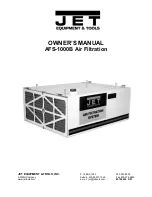
Technical Manual: TM80030
THERMICA WATER TO AIR COOLER
Model range: THERMICA10-VV-MMM-LLL
Revision: 1.0
Date of release: 2022-12-16
40/55
www.vareximaging.com
6.3.
Preventive checks
It is recommended to perform preventive checks on a regular basis. The interval of these checks shall be
tailored to the application and frequency of use.
Action
Checkpoint
Visual inspection on all outer parts
No damage of parts
Check electronic functionality
1.
Ensure the controller is working
2.
Check the presence of alarms
3.
Check if all connectors are connected in the
right way
Check for cooling fluid leakage
Hydraulic connections
Check for dust clogging
1.
Between fins of radiator
2.
In air filter (when installed)
Check for clogging of the coolant filter
Coolant filter in filter block
Check if the settings match with the cooling
application
See §3.10 for default setting and §5.6 for
parameter settings
6.4.
Maintenance interval
It is recommended to perform maintenance checks on a regular basis. The interval of these checks shall
be tailored to the application and frequency of use. See also §6.5.
6.5.
Maintenance checks
It is recommended to perform maintenance checks on a regular basis. The interval of these checks shall
be tailored to the application and frequency of use.
Action
Checkpoint
Cleaning between the fins of the radiator
Blow with compressed air from the inside to the
outside of the cooler to remove dust particles
Cleaning the hydraulic filter
Filter block. Remove, clean with water and
replace the filter
Visual inspection on all outer parts
1.
No damage
2.
Clean
3.
Fixed in place
Visual inspection of all electronic parts
1.
No damage
2.
Clean
3.
Fixed in place
Check on all mounting points
1.
No damage
2.
Fixed in place
3.
Fasteners still tightened
Check electronic functionality
Ensure that the buttons of the controller are still
working
6.6.
Draining the cooler
Draining the cooling liquid is done by closing the ball valve by using tool C firstly. The ball valve is closed
when the slot in the screw of the ball valve is vertically orientated. Unscrew the sieve cap by using the
same tool turning counterclockwise. If this does not work, use a wrench size 32 [mm]. The filter/sieve
clamps in the sieve cap and will automatically come out of the filter housing. Put a bucket underneath the
opening. Remove the filling cap and open the valve again and retain the cooling liquid. See Figure 15.
















































